BYOAD: Multiple Perspectives: Weekly Updates
Project Overview
WEEK 1 | WEEK 2 | WEEK 3&4 | WEEK 5 | WEEK 6 | WEEK 7 | WEEK 8
Week 8 (Due 4/28/21)
This week I updated our prototypes to include the postcards that Wendy made! I also played around with the audio, however, Figma doesn’t allow you to add any – Shehara
Added AR userflow/prototype to the Figma – Dazhen
AR could provide a way to scan the postcard or picture to listen to the audio description, but SparkAR to Instagram’s userflow is a little complicated and not that accessible. Another advantage of this way is to encourage visitors to share and comments about the history museum or exhibits.
If AR app could be provided for users to download, it might be easier to use.
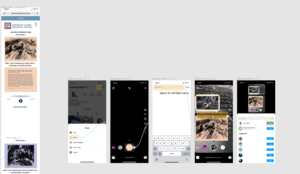
Week 7 (Due 4/28/21)
Some examples for postcards that can be provided to complement the exhibition. The text needs to be reviewed and references to be added. (Wendy)

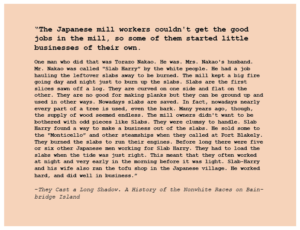
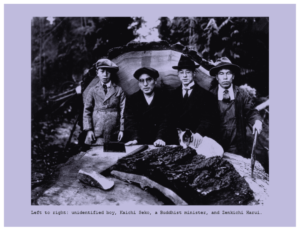
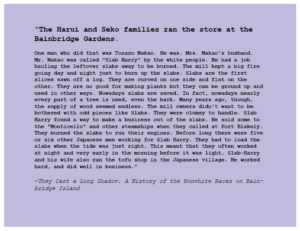
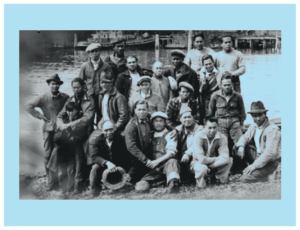
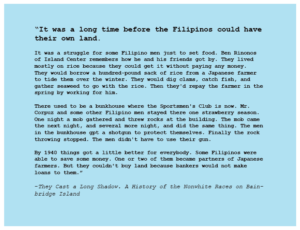


I worked more on the templates for the website. Using the quotes we found from the websites we were given, I made a prototype that shows what happens when you click Show and Hide transcript. We are still working on getting the audio for the quotes! – Shehara
Week 6 (Due 4/14/21)
Worked with Nelson from the templates team to create a prototype for what the multiple perspectives would look like on the website (Shehara)
Ecology and the effects of logging:
I did research on how logging impacts the environment and further growth. I found that logging/clearcutting will delay further growth, wipe out animal and plant species, contribute to further forest fires, and increases compound gases in the air, contributing to climate change. On Bainbridge, colonizers eventually forced the Squamish tribe to relinquish their land so that they could further destroy the forests.
https://digitalcollections.lib.washington.edu/digital/collection/imlsmohai/id/4253/
https://www.historylink.org/file/8274
https://dahp.wa.gov/sites/default/files/PortBlakelyMillCR_Report.pdf
AR demo (Dazhen)
Try this link: https://www.facebook.com/fbcameraeffects/testit/788328758471794/ZWZmN2M0OGJjMDYzZmY0YWZhNjllNDJiNjAwMGM2M2Q=/ You could copy this link into the browser, then open Facebook camera.
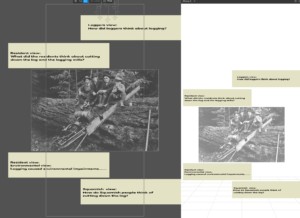
When the user scan the logging image, there would be stickers of multiple perspectives shown around the picture. And there would be sounds of interview recordings or audio to read the text aloud.
The problem I still have to fix is that the text is not clear enough to read, and it would blink on the screen.
Referred to these instructions:
https://sparkar.facebook.com/ar-studio/learn/articles/world-effects/target-tracker/#adding-target-tracking
https://stackoverflow.com/questions/59736959/cant-import-audio-to-spark-ar
https://online-audio-converter.com/cn/
https://sparkar.facebook.com/ar-studio/learn/tutorials/audio-basics/#adding-interactivity
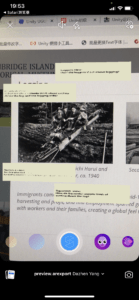
Week 5 (Due 4/7/21)
Research
AR Storyboard/Conceptualization (Shehara)
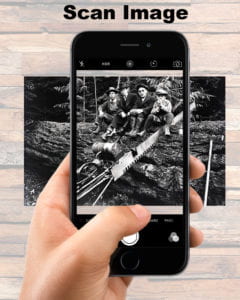 |
 |
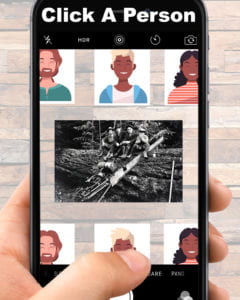 |
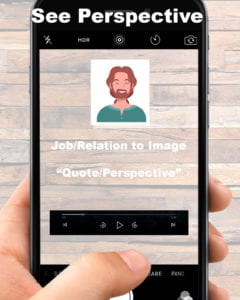 |
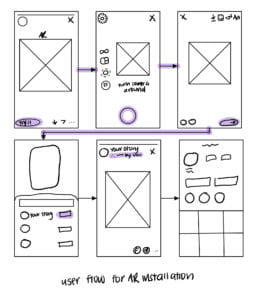 |
Week 3&4 (Due 3/25/21) (Feedback Form)
Research
Shehara’s Notes
- This week I worked mostly on looking into the AR side of things. I watched a bunch of tutorials on Spark AR and tried to come up with ideas for how we could best implement it. Here are somethings I came up with
- Use image trackers (a qr code or image of an item from the exhibit) when you can the image with your phone, it will come up with a bunch of people’s pictures surrounding the object/exhibit. When you click on the people’s images it will start to play the quote of their perspective of the exhibit.
- Another idea I had was to give the background information using AR so when you scan the object/exhibit it will tell you the history behind the object, what year is it from, why was it created, why is it important, people related to it. Maybe we can also have a feature that details similar exhibits that are in the museum
- Lastly, I thought that we could use AR to guide people around the exhibit – kind of like what to look at first and guide them sequentially through the exhibit.
- Some of the drawbacks of using Spark AR however is that since it is still a new software, they haven’t added the capabilities to add captioning to an experience – therefore we would have to hard code the captions in which wouldn’t be sustainable for people who don’t know how to use Spark AR
- Here are some notes I took from our discussion 2 weeks ago
- Participatory perspectives – how can they think of the different types of communities they can tap into. At intrepid, they have former crew members, and people who put the exhibit who could reflect on their experiences. Setting framework for different communities – creates
- Thinking about things that could be used in a wide variety of places. Think about their staff – high and low tech. Approaches to collecting information, what questions to ask, E: We are also eager to find ways to have the interpretation be available on-site – in person
- I: Get to go to the place where history happens – go back to the physical version as well – sickbay – perspectives from doctors, someone who was getting treatment, people’s stories – how visitors could go through these spaces and go through it themselves
- E: it’s great that you’re reading a lot and expanding ideas – in terms of developing a prototype helpful to see how this interpretation could happen on site. For it to be effective, in the physical environment – Sick Bay – emergency medical services that everyone took advantage of – could also pharmacists and chemists and learn about the creating of different medications – could be as simple as Audio stations to learn the perspectives of a former crew person, 21st-century naval doctor – developing a strategy for what communities you want to invite to your project
- Recommend with one of the other historic site museums – write a few bullets of what we want – will communicate with collaborators.
- Look at annual reports to see how their audience is
Dazhen’s Notes
- Reading The White House Visitor Center: a case study in inclusive exhibition design
- Large tabs or knobs for people with difficulties in motor coordination could help them to turn panels and flipbooks easily. Similarly, on digital interface, we should ensure buttons easy to press and prevent pressing wrong areas by mistake. And fo our project, AR model might be allowed for users to rotate on the screen, so that they could see it in different angles. So we need to consider how it could be easy for users with difficulties in felxibilities of fingers to figure out how to rotate the model. Should we just provide two arrows for certain angle of rotating each time clicked, or just to wipe on the screen to rotate the model freely?
- In the reading, tactile maps are mentioned several times, which is an efficient way for visitors to understand the whole space and floor plan. And audio description should complement to visual and tactile experiences, so it inspired me that we could combine tactile map with audio description, that having sensors inside the map.
- While researching and user testing, there might be some conflicted opinions and feelings, how could we deal with it? Sometimes it is difficult to meet everyone’s need and realize universal design.
- Technology part
- https://docs.unity-ar-gps-location.com/guide/#quickstart
- There is truly some limitations in Spark AR, so we might try to engage with Unity, Vuforia and the GPS plugin.
- We could decide the tool to use after we finished the concept phase when we should fully consider the conclusive design and interaction process.
Melissa’s Notes
- Visitor Participation: Opportunities and Challenges: https://static1.squarespace.com/static/58fa260a725e25c4f30020f3/t/594aa8b046c3c41074e1ba27/1498065077680/9+EXH+Spring10_Visitor+Participation_Simon.pdf
- Goes into the ways different types of museums can be open to visitor participation but also delves into the challenges that they will face from it
- The “Virtual Museum”1 : New Perspectives For Museums to Present Objects and Information Using the Internet as a Knowledge Base and Communication System http://www.informationswissenschaft.org/wp-content/uploads/isi/isi1998/14_isi-98-dv-schweibenz-saarbruecken.pdf
- How the virtual museum can provide more opportunities for engagement in a technological world
- Embedding civil engagement in museums https://www.tandfonline.com/doi/full/10.1080/09647771003737257?casa_token=6_QtirlpKfgAAAAA%3AlzivR_qVWPwdEMNH_TTvWL6xhLYRt2NXy5jbsrDmjvy_1Q8kB8fFOv0bAnQ6uvX58ZcEV7pb-wcf
- How to make sure museums are learning, social, and memory institutions, etc
- Points on inclusivity and community involvement, debate and discourse
- A very informative read
- Dismantling the Master’s House: Thoughts on Representing Empire and Decolonising Museums and Public Spaces in Practice An Introduction https://www.tandfonline.com/doi/full/10.1080/09528822.2019.1653065
- About decolonizing museums and showing authentic perspectives shifted away from white euro-centric views
Wendy – ideas for physical interactions
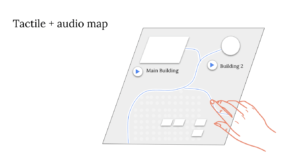

Week 2 (Due 3/11/21) (Feedback Form)
Research
- Further Research on Multiple Perspectives as well as some UX designs for the website (Shehara)
- Tara Chadwick – Multiple Perspective Interpretation in a Historical Museum Context
- is a participant in their own existence. Everyone brings their viewpoint to bear on their interpretations of the six steps of the scientific method: observation, theory, hypotheses, testing, conclusion and analyses
- People to Ask for their perspectives on different exhibits
- Professors who are knowledgeable in the area/topic that the exhibit covers
- Curators from other museums that are similar (ie/ historical v fine art)
- Directors of different programs at universities that relate to the exhibit
- Visitors of the Exhibit from different parts of the country
- Kids, Adolescents, Young Adults, Adults – based on the content of the exhibit
- People who have cultural ties to the exhibit
- Other artists who create similar work – or is interested in that field of work
- Examples of Multiple Perspectives at Different Museums
- Boston Museum of Fine Arts – for Folk Art
- There is a pay wall
- Victoria and Albert Museum – Frida Kahlo
- Free Video
- American Museum of Natural History (From Melissa’s research last week) – Equestrian Statue
- Webpage – laid out really well
- Museum of Contemporary Art in Tokyo – contemporary art
- It was a paid exhibit you could go to
- American Folk Art Museum
- Asked people to submit their perspectives – Google Form
- Boston Museum of Fine Arts – for Folk Art
- Some UX concepts we could use for the website design
- Tara Chadwick – Multiple Perspective Interpretation in a Historical Museum Context
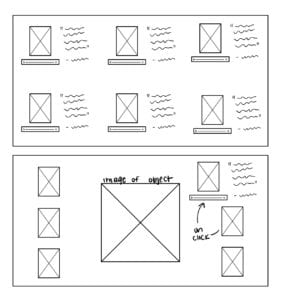 |
 |
Melissa’s Notes
- Why is having multiple perspectives important?
- Psychology standpoint: https://www.psychologytoday.com/us/blog/constructive-controversy/201906/the-importance-taking-the-perspective-others
- https://arpdcresources.ca/resources/ssparentnewsletters/pluralism_newsletter.pdf
- Multiple perspectives allow more respect to be given to other cultures
- History https://teachinghistory.org/teaching-materials/ask-a-master-teacher/23610
- Underrepresented groups are typically erased from a historical narrative which is why their voices need to be heard more
- A need for the voices of more racial minority groups and women, as well as more respect for the cultures being presented
- History has often buried these voices and taken away their perspectives, doing so now is crucial
- https://journals.le.ac.uk/ojs1/index.php/mas/article/view/338/345
- The way objects, specimen, and artifacts are presented changes the meaning and value of them
- The different perspectives give an alternative view
- Objects can be used to represent different aspects of a cultural/historical event
- Who should be giving the perspectives
- Historical: objective
- The same narrative can remain but there must be an emphasis on who this narrative is coming from and what their biases are
- The different groups involved in the object’s history should all be represented
- Whether this be through historians, professors, or every day people
- Those within certain cultural groups may have differing opinions so having more than one perspective is important
- Important questions could be,
- “What does this object mean to this culture currently and how is it tied into their history?”
- Art: subjective
- Art is typically more subjective and therefore open to interpretation
- Views on art could be taken from art critics, educators, museum curators, but also average people across the world
- Questions could be
- “How do you interpret this object?”
- “What does it mean to you?”
- Historical: objective
Dazhen’s Research
- Multiple perspectives
- Multiple Perspectives on Beuys
- The exhibition interprets ‘multiple’ in another way other than the individual’s various opinions but different forms that could convey the art work.
- Distribute art and idea to a wider audience.
- different display strategies to place the multiples in the artist’s own cultural context.
- Opportunities and Challenges for museums pursuing participatory visitor engagement
- History museums
- Community Dialogue programming & comment boards
- accuracy and authenticity
- Art museums
- creative social activity
- Distraction from the aesthetic experience with connection to exhibits
- Science museums and centers
- participatory design challenges
- Off-topic inappropriate ways
- History museums
- Multiple Perspectives on Beuys
- Augmented Audio
- Morgan Library & Museum
- Create audio narrative
- Spatial audio recording
- LISTEN: a user-adaptive audio-augmented museum guide
- Inherent everyday integration of aural and visual perception
- Immersive, natural personalized experience in art exhibitions
- Morgan Library & Museum
Wendy –
Week 1 (Due 3/4/21) (Feedback Form)
Research
Our research includes: examples of similar projects being done, the practicality of building the experience (technology, timeline… etc.)
- Research multiple perspectives (Melissa)
- American Museum of Natural History https://www.amnh.org/exhibitions/addressing-the-theodore-roosevelt-statue/perspectives-today
- Multiple perspectives on the statue of Theodore Roosevelt on a horse with an African American man and a Native American man standing below him
- Perspectives were taken from professors and educators of history, indigenous studies, museum studies, etc, museum directors, and visitors from NYC and other states in the US.
- Smithsonian Learning Lab https://learninglab.si.edu/collections/exploring-multiple-perspectives-with-american-art/vfmvuz2fcNP8tkqt#r/558667
- This lesson plan implores students to ask themselves questions while they view historical American art. Questions asked to include “What do you see?” “What do you think about it?” “What does it make you wonder?”. Additionally, it lists the following:
- “Step In: What do you think this person might feel, believe, know, or experience? “
- “Step Out: What would you like or need to learn to understand this person’s perspective better?”
- “Step Back: What do you notice about your own perspective and what it takes to take somebody else’s?”
- This lesson plan implores students to ask themselves questions while they view historical American art. Questions asked to include “What do you see?” “What do you think about it?” “What does it make you wonder?”. Additionally, it lists the following:
- LACMA “Home” Exhibit https://www.chicano.ucla.edu/files/news/GuardianLibertyVoice_LACMAExhibit_061017.pdf
- The “Home” exhibit offers approximately 100 different pieces all relating to the theme of “home”. Juxtaposing different objects and art together to show alternate perspectives of the theme and allowing visitors to easily compare and contrast.
- Divided into subcategories of “Model Homes”, “Archelogy of the Home”, “Mapping Home”, “Recycled Homes”, “Home as Forms”, “Embodied Homes”, “Troubled Homeland”, and “Going Home”
- This variety comes from all different artists to show the difference of meaning from multiple perspectives
- Change of Museums by Change of Perspective: Reflecting Experiences of Museum Development in the Context of “EuroVision—Museums Exhibiting Europe” (EU Culture Programme) https://link.springer.com/chapter/10.1007/978-3-319-29544-2_9
- Goes over how important it is for museums to be able to provide historical information in an accessible way and to continue transmitting its meaning
- With society continually changing and shifting, museums need to adapt to portray a wider array of perspectives for their audiences.
- With more “migration” places are becoming more mixed and blended, which means more perspectives need to be included to appeal to younger audiences especially
- Seems like some museums offer different/multiple perspectives on different exhibits but often do not. I was able to find some examples but it seems like there is mostly research articles and books describing how museums can offer multiple perspectives and that is their duty to offer them to their visitors
- American Museum of Natural History https://www.amnh.org/exhibitions/addressing-the-theodore-roosevelt-statue/perspectives-today
- Research social narratives (Shehara)
- Smithsonian Social Narrative
- They only had one
- Maybe we can look at creating video versions or multiple versions that are more customizable for different people
- Maybe a checklist and then based on preferences it creates a social narrative fit for you
- They only had one
- Smithsonian Pre-Vist Videos
- They are usually pretty short – under 5 min
- Intrepid Museum
- Hard to locate the social narratives
- Only one perspective
- Maybe we can do something like this for the social narratives
- Include sensory guides?
- New Museums Social Narrative
- Their social narrative focuses on “visitors on the autism spectrum and/or people with sensory sensitivities”
- I think that the document is very well laid out, the images are clear and provide visitors with a really great perception of what happens when you get there
- I do think that they should have more social narratives with people with other disabilities
- Mac Access created a Learning Module to help people create Social Narratives. I think that this is a great guide for how to first approach a social narrative. They break down step by step what information visitors need and how you can fill that need.
- The Mets Social Narrative
- I really liked the Mets Social Narratives because they had 6 different ones for different family sizes and different ages.
- They were also super super in depth and linked to different resources throughout the museum
- I also liked how they added information for people to contact them if anyone had any questions.
- Aspen Art Museum
- They created diagrams for different situations which I found to be super helpful
- At the end of the document they included all the accessible areas of the museum and where they are located.
- I also found this NYU Website about Social Narratives that I think Amy and Anita might have made – it has a lot of super useful information.
- Has templates as well as other information they can include.
- Overall somethings we can implement are
- Making the social narratives videos
- Creating a module for people – it would be more immersive
- Adding extra info into the social narratives and from different perspectives
- Smithsonian Social Narrative
- Research access/engagement while visiting–AR (Dazhen)
- Research
- Smithsonian National Museum of Natural History
AR app in the iconic Bone Hall. This app, called Skin and Bones, shows what the skeletons would have looked like while alive.
- Smithsonian National Museum of Natural History
- Research
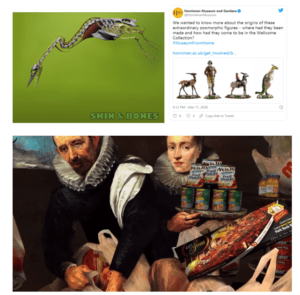 |
-
-
-
- The Art Gallery of Ontario
Add some animation to the art, which could help to tell the story and make the scene more vivid. “transform a simple interaction — viewing a painting in a museum — into a visceral, explorative and magical experience.” - A New Model for Access in the Museum
- The reading inspired me about how people communicate and discuss could be an interesting and meaningful engagement in museums. Since different opinions and perceptions are also part of the art, if AR could record these ideas and show these to more people, which could meet the social demands of museum and historical sites’ engagement.
- Engage with visitors during the pandemic https://blooloop.com/museum/in-depth/museums-coronavirus-social-distancing/
- Virtual Collections:360-degree views of the Smithsonian National Museum of Natural History exhibits This VR exhibition document and show details well, but AR could help to bring these exhibits out of the glass window and get visitors closer to exhibits.
- Museum From Home:Several museums are tweeting interesting facts, videos and insights about their collections with the hashtag #MuseumFromHome. It’s the most simple, effective and convenient way to appreciate art in daily life.
- Education for kids:Some museums would provide some video for kids to educate them about history, culture and art.
- The Art Gallery of Ontario
-
- Ideas
- AR description that could describe information in text more intuitively for people with cognitive disabilities who have difficulty in reading long paragraphs and for non art-educated people. To improve engagement while keeping social distance during coronavirus.
- Bring exhibits into daily life using AR. i.e. Users could scan walls to see exhibits on the street, which is GPS-based, like Pokemon Go. For non art-educated people.To improve engagement while keeping social distance during coronavirus, and find a new way for museums to break the space constraints and enlarge audiences.(This could also be a part of social narrative during pre-visiting)
- Add AR form of animation or video into social narratives for teenagers.
- New way to add audio guides using AR, so that users could hear the text description in front of them scanning the exhibits using their phones’ AR function. For vision-impaired.
- Questions
- Does accessibility design include design for non art-educated people who could be considered as cognitive disability in museums? (Since they could not understand the jargon.)
-
- Research sonification of museum space (Wendy)
I haven’t found an example of a museum using sonification to present their exhibition. However, there are quite a few examples of how this experience can be done:- Sonification of space:
These are field recordings of sounds while visitors walk inside a museum. The audio gives the feeling of the size of the space, sound of installations, crowd around you and the material of floors / stairs. It can be provided as an experience of the space, or layered with auditory descriptions to describe the space with detail. - A Sound Map of the Art Institute of Chicago
https://soundcloud.com/3leaves/john-kannenberg-a-sound-map-of-the-art-institute-of-chicago - A Sound Map of the Egyptian Museum, Cairo
https://vimeo.com/31091267 - A Sound Map of Tate Modern (Montage)
https://vimeo.com/131003131
Sound can be experienced in 3D, further conveying spatial information:
- 3D audio experience of a barber shop
https://www.youtube.com/watch?v=IUDTlvagjJA
- Sonification of assets:
These are transformations of visual elements that can be further applied to the sonification of an object or a space. Visual elements can be collected data, which is used to make sound.- Sonification of colors:
A color is transformed into a sound based on how it makes us feel
https://munsell.com/color-blog/hear-the-rainbow-color-sound/ - Sonification of an image:
For an image of the Milkyway, the intensity of the light in the images is set as the volume control, while stars and other ‘compact sources’ are translated as individual notes. The space dust and gases are played as a fluctuating drone, and the vertical position of light controls the pitch.
https://www.dpreview.com/news/0053888451/nasa-translates-milky-way-images-into-sound-using-sonification
https://chandra.harvard.edu/photo/2020/sonify/ - Sonification of shape:
ITP faculty Yeseul Song has created “invisible sculptures” felt by sound:
https://yeseul.com/Invisible-Sculptures-1-6 - There are some research articles on how to sonify the surface of 3D objects:
https://www.researchgate.net/publication/316190245_Sonification_of_3D_Object_Shape_for_Sensory_Substitution_An_Empirical_Exploration
- Sonification of colors:
- Sonification of space:
What are we doing next week?
- After doing our individual research, we are going to finalize what direction we want to go to with for the project (All)
- Do more research about the practicality of our ideas (All)
- Choose more concrete goals and outcomes (All)
- Start to look at big picture ideas and narrow them down to smaller details (All)
- Figure out who is working on what (All)
- Reach out to Beth and Elaine and ask them what they think about the outcome of our project and whether or not they think it is a good idea (All)
Our Google Feedback Form